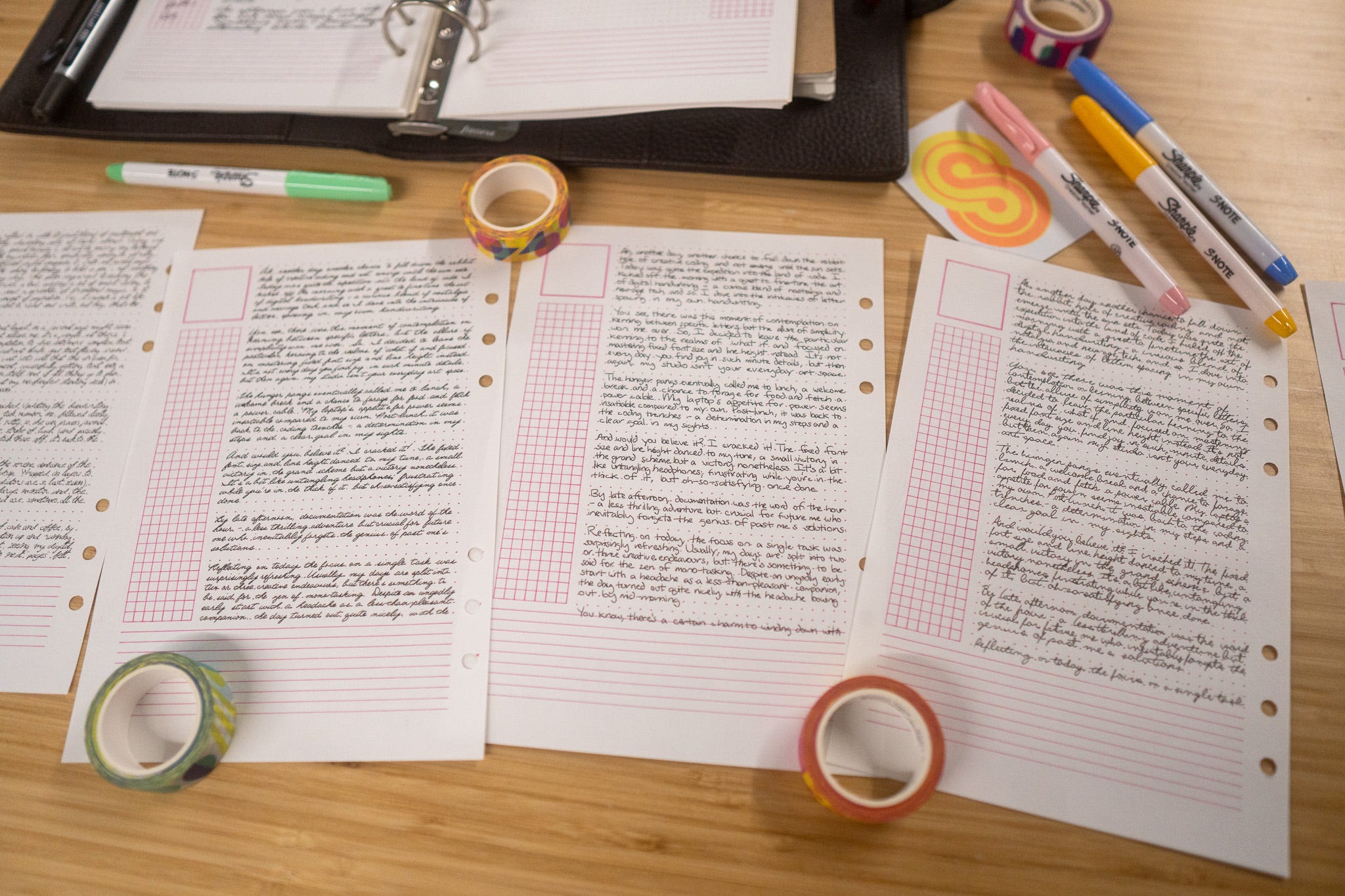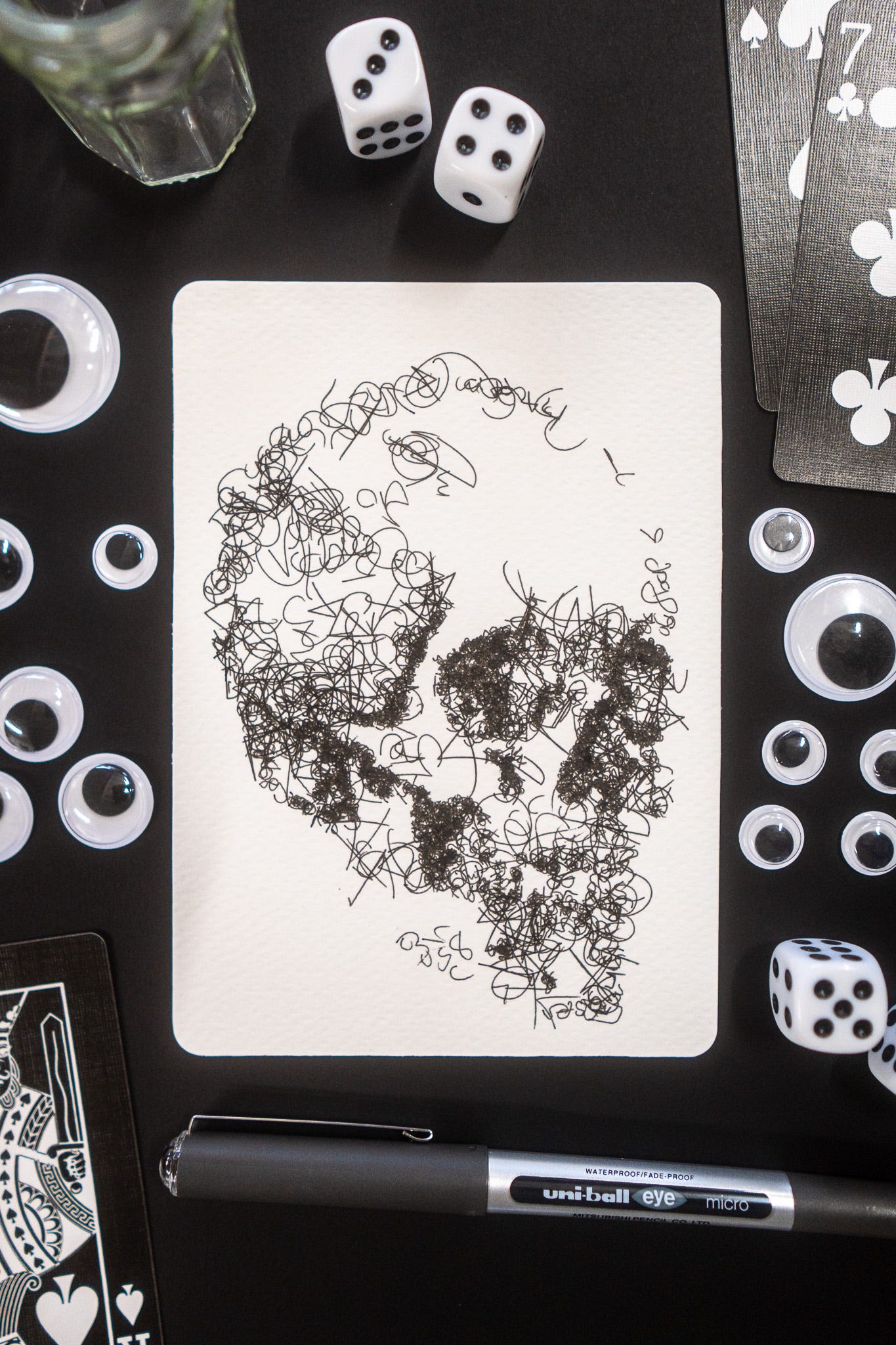📙 #031 - Chipping away at words, artist statement
Simply; "As an artist, I want the computer and drawing machine to create art for me in a way I can control and understand."
# ARTIST STATEMENT
I am definitely not good at this. How people pick the right words, the perfect word for the occasion, is beyond me. Writing any old words, like this newsletter, is not easy, but I've practised it enough that it's doable. Choosing the correct words for something even more important is like pulling teeth.
So, I've spent the last two weeks writing my three-paragraph Artist Statement. Not the WHOLE three weeks, obviously; much of it was spent procrastinating and avoiding writing it. I'll paste the statement in at the end of this section.
This is what I learnt.
Buy Vicki Krohn Amorose's book Art-Write, The Writing Guide for Visual Artists; it's terrific.
Buy one of these, "How to do presentations" by Russell Davies. I bought a whole pile of them to give to friends who need them. Ummm, if I give you one, then it's just an extra one I had; I don't think you need the advice, of course!!
It says it's about presentations, which it is, but it'd be excellent advice for any form of communication.
They both have these three critical pieces of advice.
Keep it short & simple
Have a point
Work in threes
I could go to great lengths (and have gone to great lengths) to explain what I do. I can write about generative art, algorithmic art, drawing machines, studio management, productivity, and everything else I do and how it interconnects for pages or hours and hours.
Vicki teaches us to keep the "art-speak" out of your statement; you know the thing, basically anything ChatGPT churns out, "I straddle the boundary between the integral elements of creative expression and..." 🤮
This was the most challenging part. I have so many notes and explanations of what I do written down that whittling it down, making EVERY WORD WORK for its place in a sentence, and making every sentence work for its place, too, is beyond my skill set. I didn't manage it, but I gave it a go.
I wanted to be perfect, but I eventually accepted that it won't be and that you're allowed to change your artist statement over time (and encouraged to, in fact).
Also, vanity and ego told me I wanted to appear fancy and clever, and if I stripped all the fancy & clever words out, then it (and therefore me) would look pretty basic.
At the end of the day, my job was to tell people what I do in a way that pretty much anyone could understand while opening up to further questions.
If I really wanted to get to the point, this would probably work as the whole thing.
"As an artist, I want the computer and drawing machine to create art for me in a way I can control and understand."
...but even that, I had to distil down from what I had rather than manage to jump right there. Making stuff simple takes a lot of work.
Three paragraphs are about right, that rule of three again.
Beginning -> Middle -> End
Medium -> Process -> Understanding
Problem -> Solution -> Plan
How -> What -> Why
What -> How -> Why
What -> Why -> How
Anyway, let's just put the fucking statement here, shall we? It's still ego-driven; some words are superfluous, but it'll do for the moment.
I am a contemporary-print artist and I primarily use computer code to generate artworks for drawing machines, traditional print and sometimes screen. Much of my work focuses on using code to create multiple automated compositions. Where I'm often choosing pieces to feed back into the system as an iterative process or selecting them as the final artwork. I'm acting as the instigator and curator, while code, technology, and the drawing machine, with it's pens and ink, takes the role of creator.
My current approach has been driven by a desire to augment the laborious aspects of art studio administration (the boring parts of the job) with custom-built tools and AI. In doing so I've discovered that these tools have been expanding into my art practice itself, with the drawing machine acting as extension of myself both in the creation and documenting of the art.
In an attempt to understand my interactions with code, AI, the drawing machines and documentation I've started a year of Arts-Based Research, focusing on synthesised handwriting, AI assisted journaling and the processes involved in running an art-studio. The primary outputs will be documentation of this research, which may also produce drawing machine, print and sometimes screen based artwork as secondary outputs.
I added it to my website (Adobe’s TypeKit continues to be a pain), now I can get on with my life.
### Timing and Schedule
I've previously mentioned working in 12-week chunks (a practice from the 12-Week Year book), with the 13th week being a reflection/planning week.
At the start of this current 12-week chunk, I didn't know I would pivot halfway through into Art-Based Research or even what that was. This is why four weeks ago, I gave myself two weeks to skim-read many books about it, come up with my research topic (see last newsletter), and then two more weeks to come up with an artist statement (see mum, this newsletter).
Next week is the 13th in-between week, which will be full of planning. So that means the week after, I'll be starting my 12 months of research proper.
Which is mainly just carrying on with what I normally do, but using both my research statement and artist statement as a North Star to try and prevent me from getting distracted by anything fun[1]
# JOURNALING AND HANDWRITING UPDATE
I re-encoded my handwriting, which my local handwriting SVG server can now use. However, for now, I'm still using one of the other styles while ironing out a few things.
But the short is I now have Kitty (my AI PA) with her[2] drawing machine writing journal entries for me. I'll cover this in more detail another time, but it comes back to my dislike of spending time writing words.
This is how it works: each day, Kitty asks me five (AI generated) questions in the morning; the last two are always the same. Here are the questions from yesterday.
Reflecting on your recent experiences with focusing intensely on tasks like the artist statement, how might you apply a similar level of dedicated focus to today's projects to enhance your productivity and creativity?
Considering the insights gained from trimming and refining your artist statement, what's one thing you're looking forward to exploring or creating today that aligns with your clarified artistic direction?
As balancing intense focus with well-being is crucial, what's one specific way you plan to incorporate a break or self-care into your busy schedule today to maintain a healthy work-life balance?
What are your plans for today?
Anything else you want to mention?
The first three questions are generated by looking at the questions asked and answers I've given for the past seven days.
Throughout the day, Kitty would randomly interrupt me to ask, "Hey Dan, what are you working on at the moment?" - she just asked me this, so I told her I was writing the newsletter.
Then, at the end of the day, Kitty will ask three more questions based on what I've previously answered for the day. Yesterday, these were...
Reflecting on today's focus on your artist statement, how do you feel about the progress made and its impact on clarifying your artistic identity or direction?
Considering your morning intention to solely focus on your artist statement and seeing it through to completion, how did maintaining this focus influence your overall productivity and mood for the day?
As you pushed to finalise your artist statement today, what's one insight or realisation you had about your work or your goals in the process of trimming and refining your words?
Plus
Anything else you want to mention?
As what I'm doing changes over the days and weeks, the questions Kitty asks adapt and change, too. I've never managed to stick to journaling before and always got bored of more general prompts, so this is working really well for me. Plus, because I'm trying to answer the questions sincerely even though sometimes they can be a bit irrelevant[3], I now have a pretty good record of what I've been doing daily going back nearly a year.
Anyway, the most recent step has been asking Kitty to wrap up the questions and answers into a daily journal entry written in my style (I fed her my newsletters and blog posts for that) and then use the drawing machine to actually write them out onto my journal pages, which I then annotate and add notes to in the margins.
I'm not sure I could tell you exactly why I'm doing this yet, but it wouldn't be part of my year-long research if I could.
# END
Enough!
For someone who's spent the last two weeks reducing words, I'm not doing a very good job here.
I don't have a good CALL TO ACTION this week (again), so I'm going to drop a link to Ploterre (again): https://ploterre.com/ "ploterre explores the natural world using data in place of a map and shares these journeys through hand-crafted pieces." Signing up for her newsletter will bring you data visualisation and print joy.
Love you all
Dan
❤️
P.S. You'll receive my next newsletter around April 4th.
[1] What I'm doing is fun, but other things seem more fun when I'm doing it.
[2] "Kitty", the AI, is named after the Kitty Terminal program I run it in. However, Kitty has been referring to itself as "she" and "her", so who am I to argue?
[3] For example, on a Sunday, when I tell Kitty I've been playing Cyberpunk 2077, a Monday question could well be, "What elements or lessons from your joy of playing the Cyberpunk game could you bring into your art practice today?" - which at first glance isn't relevant, but if I sit and think about it a while I can generally pull something together.







